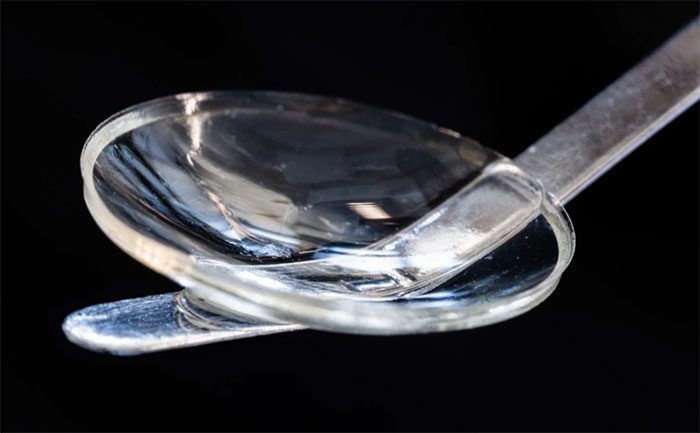Biologically engineered corneas have restored vision for individuals with impaired eyesight, including those who were blind prior to receiving the transplant.
These corneas, as described in the journal Nature Biotechnology, could help restore vision for people in countries with a shortage of corneal grafts at a lower cost. Unlike human corneas, which must be transplanted within two weeks, these biologically engineered grafts can be stored for up to two years.
Corneal transplants are made from collagen protein extracted from pig skin, which has a structure similar to human skin. The pure collagen molecules have been processed to ensure that no animal tissue or biological components remain. Subsequently, the research team from Linköping University in Sweden stabilized the loose molecules into a hydrogel scaffold resembling a human cornea, strong enough for implantation into the eye.

Cornea made from collagen protein extracted from pig skin, similar in structure to human skin.
Surgeons in Iran and India conducted a pilot study involving 20 individuals who were blind or nearly blind due to keratoconus. This condition thins the cornea, the outermost transparent layer of the eye, impairing proper focus. The transplant restored the thickness and curvature of the cornea. All 14 participants who were blind before surgery regained their vision, with three achieving perfect 20/20 vision.
Although corneal transplants for patients with keratoconus typically involve suturing, the team tested a simpler and safer surgical method. They used a laser to make an incision in the center of the cornea before inserting the graft, promoting quicker healing and less post-operative inflammation. Consequently, patients only needed to use immunosuppressive eye drops for eight weeks, while those receiving traditional grafts often require immunosuppressants for at least a year.
Surprisingly, the graft changed the shape of the cornea enough for recipients to wear contact lenses for optimal vision, despite previously being unable to tolerate them.
The cornea helps focus light onto the retina at the back of the eye and protects the eye from dirt and microbes. When damaged by infection or injury, it can prevent light from reaching the retina, making it difficult to see.
Corneal blindness is a significant issue: it is estimated that around 12.7 million people are affected by this condition, with cases increasing at a rate of about one million each year. Iran, India, China, and countries in Africa have particularly high rates of corneal blindness, especially keratoconus.
Neil Lagalo, a professor in the Department of Biomedical and Clinical Sciences at Linköping University, stated that since pig skin is a byproduct of the food industry, using this biologically engineered graft will be more cost-effective than donor corneal transplants.
He shared, “It will be affordable, even for people in low-income countries. It saves significantly more costs compared to the traditional corneal grafting methods currently being performed.”
The research team hopes to conduct a larger clinical trial with at least 100 patients in Europe and the U.S. In the meantime, they plan to begin the mandatory management process for the U.S. Food and Drug Administration to ultimately approve this device for the market.


















































